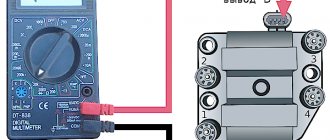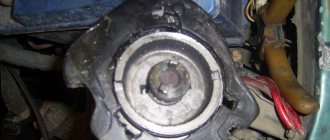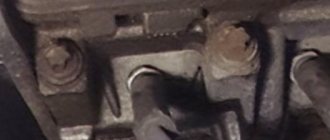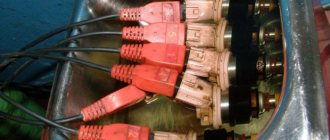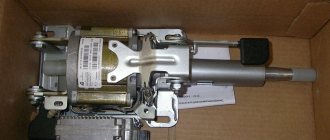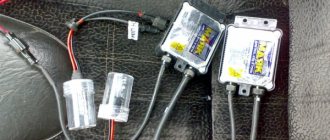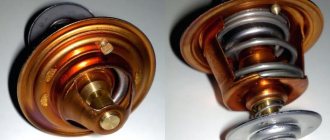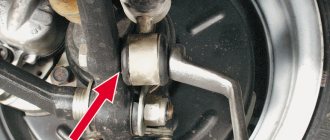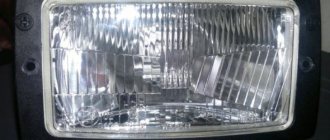Over the several years of production of the 2114 model, two types of ignition were installed on the car - contactless and electronic. If there are no problems with the second type, then with a contactless system there are problems. When there are problems with starting the engine and the stability of its operation, it will be useful to know how to set the ignition on a VAZ 2114. First, you need to know the differences between the two spark supply systems, and then carry out the repair yourself.
Useful video:
Causes of ignition problems
As mentioned earlier, in order to set the ignition in the electronic system you will have to go into the “brains”, there you can also check the functionality of the sensors, so they greatly influence the operation of the system, regardless of the type of ignition.
On the electronic type, the main causes of failures are:
- Incorrect information transmitted from sensors to the ECU. If the connection to the brain and diagnostics showed strange data coming from one or more control devices, it is necessary to use a “substitution”. The easiest way is to find a car with known good sensors, install them and double-check the results. Here you need to understand that you do not need a new one, but a working sensor, because factory defects are not excluded even on a new mechanism.
- The incoming voltage - correct from a technical point of view is 5V, but if due to a violation of the mechanical integrity of the wires or another problem with the car’s electronics, this voltage changes, the sensor readings will also change after it. If this happens, the ECU begins to adjust engine operation based on incorrect data, which leads to incorrect operation of the entire mechanism as a whole. To check this breakdown, you will need a known-good system of wires leading to the sensor or a donor car into which you can install your sensor and test the system for functionality.
- Broken ECU - if the previous two options did not give a visible result, and installing your sensor and wiring in a working machine does not change its performance, only this option remains. You can try to reflash the “brain” of the car, but due to its low cost, it is better to immediately buy a new ECU and install it on the car.
Before moving on to the radical measures proposed in the third option, it is worth additionally checking the correct location of the labels. In cars with contactless ignition, this is the ignition installation of the VAZ 2114, and for cars with an electronic system, debugging is important to check the synchronization of the injection system with the gas distribution mechanism.
Useful video
You can find interesting information by watching the additional video below: https://www.youtube.com/watch?v=pNyBny-_HoQ
On a car with contactless ignition, everything is even easier; you don’t have to remove the wheels, but you will need an assistant. It is necessary to find the compression stroke of the fourth cylinder. To do this, insert a rubber cone into the spark plug hole and turn the ratchet. Pushing out the cone will mean that the compression stroke has been found.
Having illuminated the spark plug hole, we align the longest mark of the cover with the mark of the pulley. We set the breaker to the appropriate clock and check the operation of the system according to the fourth point described above.
How to check the ignition coil?
Before diagnosing the ignition coil (SC) on an 8-valve engine, you should check whether there is voltage on the coil. To do this, you need to disconnect the wire block and check it with a tester. The voltage should be 12V.
VAZ short circuit diagram
Typical unit malfunctions
Signs of a faulty short circuit in VAZ engines with 8 valves, UAZs and other cars are similar:
- power is lost, it seems that the engine does not pull;
- the appearance of failures in engine operation;
- unstable operation at idle;
- Cylinders 2-3 and 1-4 do not function in pairs, there is no spark.
If the listed symptoms appear, you first need to check the spark plugs and crankshaft position sensor. Fuel injection into the injectors is regulated based on sensor readings, so if there is excessive fuel consumption, they require checking. The short circuit should be checked last.
You can check the ignition module (IM) on an 8-valve engine in one of three ways:
- The easiest way is to replace the module being tested with a known-good device. True, you need to find a suitable module. Before checking, be sure to make sure that the high-voltage wires are in good condition.
- The second method is to move the module. If, when you move it and the wire block, changes in the operation of the motor are noticeable, then there is a problem with the contacts. In this case, you can do the repair yourself. If repair is not possible, the device should be replaced.
- The third method is to check using a multimeter set to ohmmeter mode. It is necessary to measure resistance at the paired terminals of coils 2-3 and 1-4. It should be the same and be about 5.4 kOhm.
Common faults
Diagnostic program There are several reasons why the phenomenon of misfires in the ignition system occurs on the VAZ 2114.
- Problem candles. If carbon deposits appear on them, the gap decreases or increases, they will not be able to work properly. As a result, there are misfires in the cylinders. Quite often, spark plugs do not work for the simple reason that the car owner decided to save money and buy spark plugs of dubious quality. You should not count on their long service life and reliable operation.
- Wiring problems. Here you most often have to deal with wire wear, chafing, and mechanical damage. Sometimes the problem is solved by replacing the wiring. But in some cases, wiring can negatively affect the functionality of the devices it goes to. As a result, both the wiring and the device must be replaced.
- Contacts. Contacts may burn out, become covered in oil, or rust. Cleaning them or completely replacing them may help. The second option is preferable in order to reduce the risk of omissions occurring after a short period of time.
- Damage to the ignition coil or module. If you have a VAZ 2114 with a 1.6-liter engine, you are dealing with a coil. Owners of the newer version with a 1.5-liter engine are already solving problems with the ignition module. Regardless of this, units often fail and cause leaks. There is no point in repairing them, so it is better to immediately replace them with new ones.
- Use of low-grade fuel. The problem for many owners of domestic cars is that they, sometimes unknowingly, doom themselves to constant repair work. A trivial example is the use of cheap gas stations. Low-quality gasoline produces a poor air-fuel mixture, clogs filters, and clogs injectors. This often causes misfires in the cylinders. The right solution is to fix the problem and start using good gas stations. Their gasoline is more expensive, but you will spend many times more money on repairs if you don’t stop refueling with God knows what.
- Omissions. They also often occur due to impaired compression in the cylinders. This fault should be checked almost first.
- The gas distribution mechanism is not adjusted correctly. Its adjustment will not take much time; the work can be done with your own hands.
- Excess air enters the fuel system. This may occur due to damage to the intake manifold, wear of the rings on the injectors and other defects. Therefore, you should check the system for leaks and find sources of air intake.
- The gap between the piston and cylinder has decreased. There may be many reasons for this, but you will definitely have to check them if this is the reason.
Installation of ignition VAZ 2114 injector by marks
Ignition marks on the injector. Replacing the timing belt on an 8kL engine. Gap between DPKV and ignition pulley.
https://youtube.com/watch?v=aIOMGBmM3SM
Replacing the timing belt on an 8 valve VAZ 2114, 2115 engine. Setting the ignition to the marks.
How to quickly set timing marks on a VAZ 8kl
Timing marks 8 class VAZ! Installing the timing belt 8kl.VAZ!
Replacing the timing belt on an 8 valve VAZ 2114, 2115 engine. Setting the ignition to the marks.
Timing marks 8 class VAZ! Installation of timing belt 8kl.VAZ2108,2109,2110,2111,2113,2114,2115
We put ignition marks on the injector / Change the timing belt on an 8kl engine
Replacing the timing belt on an 8 valve VAZ 2114, 2115 engine. Setting the ignition to the marks.
Installation of camshaft, chain, ignition, according to marks, VAZ (classic). Do it yourself!
Replacing the timing belt on an 8-valve 1.6l engine!
No sounds like squeaking or whistling. But how to unscrew the crankshaft pulley when you have access to a special tool. You will get the same options as the hatchback. And then one day I stood on the roundabout. In general, a comfortable car, the trunk is fire, you put the bike in and don’t worry. A lot of my friends did things with him.
As you know, the photo 5 battery shelf located on the side wall faces the rear wall of the engine compartment. We connect the lamp in place of the standard backlight, observing the polarity. Another reasonable question: why not install Solex. Tuning cams are characterized by an exceptionally smooth profile, which ensures reliable operation of the gas distribution mechanism. All further actions are performed in reverse order. This is not possible, since the contacts of block 8212 are completely open. In fact, the attitude towards customers is good. The trunk is inconvenient due to the high wall and is small, but this can be forgiven for a three-door.
Getting ready to adjust the ignition
In order to correctly set the ignition timing of the VAZ 2114 and carry out debugging, you need to prepare. The method described below does not require acrobatic agility from the owner and is quite feasible both in the uncomfortable and cramped environment of a garage and if the car enthusiast has a tummy.
Preparation for debugging ignition marks is carried out as follows:
- The car is placed on a flat surface and placed on the handbrake.
- The second step is to remove the front right wheel, which will subsequently allow you to gain access to the gas distribution mechanism itself, which will speed up the work, make it convenient and easy, for this: a. unscrew the fastenings of our wheel and place a wheel chock under the diagonally opposite wheel (rear left); b. We lift the car with a jack, twist the wheel mounts completely and remove it.
- Finally, we need to remove the timing belt splash guard (if there is one, of course). By the way, you can not remove it entirely, but just unscrew the two lower fasteners, then it can be moved away without damaging it.
Preparation
It is necessary to prepare spare parts and other equipment for work. A new ignition switch will be needed. It is quite easy to find original parts and analogues on the Internet, but it is worth considering that it is advisable to purchase the lock “assembled”.
Catalog number of the original VAZ 2114 ignition switch: 21103704010. Approximate price: 500 rubles for a used part and 1200 for a new one.
As a replacement, you can use analogues with numbers: 09401, 24370407. Approximate price: 1000 rubles (new part).
In addition to the lock itself, you will need the following tools:
- spanners;
- chisel;
- pliers;
- screwdriver.
Before you begin, you must also remove the steering column cover and steering column switches.
How to set the ignition of a VAZ 2106 with your own hands - step-by-step instructions
1. Unscrew the spark plug of the 1st cylinder, then use a finger or a rubber plug to close the spark plug hole.
2. Using a special key, rotate the crankshaft until the compression stroke begins in the first cylinder, that is, when the piston begins to move upward. You can tell by the way the rubber plug flies out; if you hold it with your finger, you will feel it being squeezed out.
3. Turn until the mark on the crankshaft pulley matches the mark on the timing cover. If you drive on “92” or “95” gasoline, combine with the middle mark, but if on “72” or lower, combine with the long mark, which corresponds to the “0” advance angle.
4. Unfasten the latches, then remove the ignition distributor cap.
5. After turning the crankshaft, the distributor rotor should rotate to a position in which its outer contact will be directed towards the 1st cylinder on the distributor cap.
6
When the marks are aligned, pay attention to the distributor, try to draw an imaginary line through the cover latches, it should be parallel to the axis of the engine, if this is not the case for you, then do the following:. 7
Unscrew the distributor fastening nut, then turn the distributor upward. Rotating the rotor axis, align it parallel to the engine axis
7. Unscrew the distributor fastening nut, then turn the distributor up. Rotating the rotor axis, align it parallel to the engine axis.
8. Place the distributor, tighten the fastening nut without tightening it completely.
9. After this preparation, you can proceed directly to the ignition adjustment procedure.
10. Connect the “control” as follows: one end to the terminal of the ignition coil connected to the low-voltage wire of the distributor, the other end is connected to ground.
11. Turn on the ignition. Slowly turn the distributor clockwise until the control lamp goes out. If it doesn’t burn anyway, then you don’t need to do anything.
12. Next, you need to rotate the distributor counterclockwise, at the moment the control lamp lights up, fix the position of the distributor, then tighten its fastening nut.
13. Now you can turn off the ignition and put the distributor cap back in place.
After the ignition is set, it is necessary to check the correctness.
1. To do this, start the engine and start driving.
2. Accelerate the car to 45 km per hour, then turn on the fourth gear and sharply press the gas.
3. After this, after about 2-3 seconds, detonation will occur (popping, ringing of “fingers”), disappearing as the car accelerates.
4. If detonation occurs and does not disappear as the car accelerates, we can assume that the ignition is “early.” If you do not experience detonation at all, the ignition is “later”. In case of early ignition, turn the distributor clockwise by approximately 0.5-1 division. If you have the opposite later, turn it 0.5-1 division counterclockwise. When the ignition adjustment is completed, mark with paint on the distributor body the position of the middle mark of the scale relative to the block.
Now that the ignition timing of the VAZ 2106 has been set, you can collect everything and rejoice at the job successfully completed.
The procedure for connecting high-voltage wires VAZ
Diagram, procedure for connecting VAZ high-voltage wires.
First, let's decide which of the four cylinders is first?
The first cylinder in front-wheel drive VAZs is located closer to the timing belt. If you look at the engine from the front, the first cylinder is the leftmost). And then everything is simple - from left to right - 1, 2, 3, 4.
In rear-wheel drive VAZ Classic and Niva, the first cylinder is located closer to the front bumper of the car.
General tips for connecting high-voltage wires.
Checking high-voltage wires. To check the wires, you will need a multimeter tester. Check the resistance of the wires - it should be no more than 20 KOhms (in practice, the longest wire of cylinder 1 has a resistance of up to 10 KOhms). If the wire resistance is more than 20 Kom, it must be replaced. Carefully inspect the wires for chafing on parts of the motor or other wires. In case of significant abrasion, replace the wire. In case of minor abrasion, it is possible to lay the wire so that it does not rub and fix it in this position.
Laying wires. Do not try to connect the wires in a bundle. Disassemble the wiring harnesses, release the wires from the plastic holders. Connect the high-voltage leads to the corresponding cylinder spark plugs. Lay the wires so that they do not rub against each other, engine parts, or hoses. Avoid sharp bends and tension on the wires. After connecting all the wires, secure them into the bundle with special comb holders included in the delivery kit.
The procedure for connecting I/O wires to a VAZ carburetor (2108, 2109, 21099)
The central wire from the distributor cover always goes to the ignition coil (bobbin).
The outlet of the distributor cover, which faces towards the front of the car, is connected to the first cylinder.
The outlet of the distributor cap, looking down, is connected to the third cylinder.
The outlet of the distributor cap, looking rearward, is connected to the fourth cylinder.
The outlet of the distributor cap, looking up, is connected to the second cylinder.
The procedure for connecting high-voltage wires to a VAZ Classic, Niva with a carburetor and distributor.
Central wire from the ignition coil (bobbin)
1 cylinder - above the vacuum corrector. Next, clockwise, the order is 1-3-4-2.
Injection VAZ produced before 2004 with an old-style ignition module (4-pin low-voltage connector)
Actually, on the module body it is already indicated which cylinder the pins correspond to - but we duplicated them in red in case the module gets completely dirty, and you might not be able to see it in the photo.
Injection VAZ produced after 2004 with a new ignition coil (3-pin low-voltage connector)
As with the old-style ignition modules, the new coils are also marked with pins corresponding to the cylinders. But the connection order is different from the order on the old-style ignition module. Be careful.
How to set the ignition on an injector with your own hands
Injector types
The injector controls fuel injection and can also control the ignition. On all new injection machines, the ignition is set by a computer and regulated by filling in different firmware. But this was not always the case, and on older cars, the same Japanese from the 90s, the computer regulates only fuel injection, and the ignition timing is set using a distributor and is set in the same way as on old Lada models, and depending on the speed The ignition timing is adjusted using a more complex vacuum system than on carburetor Zhigulis. Sometimes, one tube breaks, and during operating mode the traction may disappear; you will have to look for and correct this defect.
Ignition system sensors and marks
For the ignition system to operate correctly, the computer needs to read the correct information from the sensors. Subsequently, this information will be processed in accordance with the fuel maps hardwired into the injector.
The main signal comes from the crankshaft sensor. This sensor shows what position the crankshaft is in at a given time and, based on it, calculates at what moment it is necessary to inject fuel, and at what moment this same fuel should be ignited, depending on the engine speed, which is also determined by this sensor.
And this is what a typical signal looks like, received by a computer from the crankshaft sensor
Pay attention to 270° - this is like the zero point, showing the computer that the engine has completed a revolution and a new cycle begins. This is achieved due to the absence of a tooth on the crankshaft drive sprocket.
How to set the ignition angle? On systems with electronic ignition control systems, this can be done using computer diagnostics that connect to the Electronic Control Unit (ECU) or the “brains” of the car. And there you can see how the engine operates in real time - what signals are received from the sensors, what engine speed, fuel consumption, injection timing, ignition timing and other input and output data.
Basically, you don’t need to change anything during operation unless you change the firmware. That is, if the machine somehow began to work incorrectly, then most likely there could be several reasons:
- An incorrect signal is received from the sensors; in this case, you can replace the supposed faulty sensor with a replacement one that is known to be working, and see if the result changes.
- The voltage in the network is incorrect and, accordingly, the sensors give the wrong signal. The input signal to the sensor is 5V, if this indicator is different, the ECU will receive incorrect input data and the engine will not be able to operate normally.
- The ECU is faulty. Quite often it happens that after going through everything possible, it turns out that your brains have flown. But don’t worry, they are inexpensive at VAZ.
Therefore, as such, the ignition is not set on injection machines, it is already built into the system, but it is worth checking whether the marks are set correctly.
Adjusting the ignition marks on the VAZ-2110 injector
When the engine is running, there are some phases that must work synchronously, the camshaft must coincide with the crankshaft, and the timing of fuel injection and ignition must correlate with them. Let's look at all this using the example of the VAZ-2110.
How to set the ignition on a VAZ 2110 injector
If the car doesn't start, it shoots, sneezes and everything goes wrong - the marks are not set somewhere and you need to sort it out.
On any car, the timing marks must be set perfectly, only then it will work normally. On the VAZ-2110, the crankshaft mark is located on the flywheel. You need to look through the inspection window on the gearbox housing; you can see the flywheel through it. It’s better to illuminate it with a flashlight, because it’s so easy to see.
If all the marks match, great, the timing belt is ideal. Now all that remains is to check whether the crankshaft sensor is set correctly.
The crankshaft position sensor on the VAZ-2110 is installed in the front part of the engine; it reads readings from the sprocket, which is mounted on the pulley. This asterisk is placed on the key. And there are a few things to check here.
Another problem may be that the crankshaft position sensor may be located too far from the pulley sprocket (maybe the sensor is slightly non-standard, or incorrectly installed), in which case the signal will be received incorrectly.
These are, perhaps, all the reasons that lead to ignition failure on a VAZ.
Necessary tool
To set the ignition on cars with an electronic system, you will need the following tool:
- Keys for unscrewing the bolts securing the timing belt casing;
- Ratchet with extension for cranking;
- A valve feeler gauge that can be used to check the distance from the crankshaft position sensor to the drive disc;
- A rag for cleaning the sensors from dirt.
If desired, you can replace the sensors with new ones (the cost of which is low). For example, the crankshaft position sensor rarely fails, but always at the wrong time.
Search
The 2nd Samara was the first front-wheel drive car from VAZ with an injection system at the beginning. The first copies of the VAZ-2114 were still sold with an eight-pole engine and a contactless ignition system, and subsequent engines already had a 100% electrical system with the same 8 valves. Before installing the ignition, it is necessary to find out what system is installed on the engine, which we will do at the moment.
It is quite simple to calculate the type of ignition system on a VAZ-2114 - if a switch is installed, an analogue of a contact ignition ignition switch, this means that the system is contactless, but with a distributor-distributor. In this case, the ignition timing is set by turning the distributor to a certain degree. The accuracy of the adjustment depends on the experience of the technician, as well as on the equipment used. However, such a system will allow you to flexibly and accurately adjust the ignition using a strobe light.
Most engines that were installed on the 2nd Samara and the tenth VAZ have a non-contact electric ignition system. There is no distributor, since the ignition timing is controlled automatically in real time and only with the help of the engine control system, electronics. The system does not require maintenance, and its diagram is shown in the photo below.
As can be seen from the diagram, which is implemented in eight-valve injectors, for the correct operation of the ignition system of the electric engine control unit, it is necessary to supply the appropriate information from the sensors. The main sensor of the system is the crankshaft position sensor. It is located on the left at the exit of the cylinder block next to the alternator drive pulley when looking at the end of the crankshaft.
Replacing the timing belt on the 8 cl engine VAZ 2108,2109,2110,2111,2113,2114,2115
Crankshaft position sensor
You may also like
The crankshaft pulley has a main gear drive, which generates electrical vibrations, and the sensor converts them into an impulse, this impulse is fed to the computer. The control unit, starting from the crankshaft position, sends a signal to the ignition module, which distributes the spark between the spark plugs.
In addition, the crankshaft position sensor sets the timing of fuel injection, so we will first monitor its condition.
Remove the time cover
Signal diagram from the crankshaft sensor: 1 - main disk of the crankshaft; 2 — crankshaft position sensor; 3 — crankshaft rotation angle; 4 - output signal of the crankshaft position sensor
Align the flywheel mark with the mark on the flywheel housing
We monitor the coincidence of the marks on the oil pump pulley and the outflow mark on the cylinder block
We check the coincidence of the marks on the camshaft drive pulley and the timing belt cover
If the three marks match, it means that the pistons of the first and fourth cylinders are at top dead center at that point. It is then that the gap between the teeth of the main disk should coincide with the boss on the cylinder block, and the 20th tooth from the gap should coincide with the crankshaft position sensor. This is when the sensor pulsates the engine control unit, indicating that the piston of the first cylinder is at top dead center of the compression stroke.
As can be seen from the diagram above, the ignition system consists of high and low voltage circuits. Because of this, there are a few things you need to know when checking your system.
You may also like
How to quickly set time stamps on 8kl weight
High-voltage wires operate on the order of forty thousand volts. In our case, such a voltage is not dangerous, but receiving a discharge even with a low current and such a voltage is practically beneficial for health and mood. Therefore, it is best to work with rubber gloves and use equipment with insulated handles.
To check the condition of the system you will need pliers with insulated handles, a standard set of tools and a multimeter
Please note that we are only testing the circuits and not the microprocessor part. This requires computer equipment and special training
- When the ignition is turned off, we check the contacts on all connectors of the system. First, install and contact the high-voltage wires in the ignition module.
- Remove the unit from the module and check the voltage at the terminals. IZ and V. The multimeter is set to low AC control. See the Ignition Module Test section for details.
Check the voltage at terminals C and B of the ignition module.
Check ignition coil pins 2 and 4 using a multimeter
Checking high voltage wires
So you can do it yourself - install the ignition on a VAZ-2114 with injection 8-valve engine. Good luck to everyone!
Error codes for incorrect ignition
Useful video:
If you have a special tester or a standard dashboard capability, some problems with the spark supply system can be pinpointed. To do this, you need to know the decoding of error codes:
- 300 – presence of misfires;
- 301-302-303-304 – detection of leakage for each individual cylinder;
- 335-336-337-358 – malfunction in the crankshaft position sensor wiring circuit;
- 342/343/346 – problems with phase distribution sensors;
- 363 – no ignition of the fuel-air mixture.
After eliminating the cause of the failure, you can reset the errors. In the absence of an on-board computer, identifying the problem using codes is only possible with a special scanner. To avoid erroneous self-diagnosis, periodically check all sensor connectors for integrity.
Ignition system sensors and marks
For the ignition system to operate correctly, the computer needs to read the correct information from the sensors. Subsequently, this information will be processed in accordance with the fuel maps hardwired into the injector.
The main signal comes from the crankshaft sensor. This sensor shows what position the crankshaft is in at a given time and, based on it, calculates at what moment it is necessary to inject fuel, and at what moment this same fuel should be ignited, depending on the engine speed, which is also determined by this sensor.
And this is what a typical signal looks like, received by a computer from the crankshaft sensor
Pay attention to 270° - this is like the zero point, showing the computer that the engine has completed a revolution and a new cycle begins. This is achieved due to the absence of a tooth on the crankshaft drive sprocket.
Question: how is the ignition set on injection engines? The spark plugs are turning black, the service center said that the ignition is delayed, and they have no basis for solving this problem, but it seems like it could be on a theoretical level.
How to realize they are turning black. 1. Screwed in new ones and started them. 5 min, turned out Dark.4. Passed 20,000, turned it out. dark. The ignition timing is set automatically once per second, and it (the timing) depends on many characteristics: engine speed, engine load (mass air flow or throttle position), coolant temperature. water, the presence of detonation. So here are the results: 1. Describe carefully under what circumstances the candles turn black??2. Change the gas station (try) 3. How much mileage per day? 4. Of course, go to the service center and look at the coincidence of marks for installing the timing belt, maybe it was installed incorrectly, or in other words, it slipped (occasionally, alas, it happens). If you go to another service center, they didn’t say anything about the ignition “late”, they themselves.
The moment of ignition of the fuel-air mixture in the combustion chamber is the moment of formation of a spark between the electrodes of the spark plug. Setting the ignition timing is the possibility of igniting the mixture at a certain position of the piston relative to TDC.
The properties of automatic ignition timing regulators are shown in Fig. 1
How to set the ignition on a VAZ 2114 injector.
Because it is easier to navigate by the crankshaft (pulley, flywheel), the ignition before TDC (advance), at TDC and after TDC (lag) is usually assessed in angular degrees along the crankshaft with the sign V' or b—" (Fig. 5) .
The scale may be in the hatch of the clutch map or otherwise on the pulley (Fig. 5). At the beginning of the mark (TDC mark in the corresponding cylinders) - on the flywheel, and at the 2nd - a pin in the cover of the gas distribution mechanism (scale on the pulley). Due to the smaller diameter of the pulley compared to the flywheel, the scale can cover the entire spectrum of ignition timing configurations.
Whatever car you have an ignition installed on, start.
The VAZ 2114 ignition module is a more advanced solution than the traditional “bobbin” coil that was installed on the “classic”. Nevertheless, checking this element should not cause difficulties even for novice motorists.
What is ignition timing and what does it affect?
Ignition timing is an important parameter that determines the operation of the accounting ignition system. Here the concept assumes the time during which the ignition system ignites the compressed working mixture with a spark discharge. It is defined as the position of the crankshaft of the car engine at the moment the impulse is applied to the spark plug in advance relative to top dead center in degrees.
This is all connected because it takes several days for the working mixture to burn in the cylinder, because the speed of propagation of the flame front is approximately 20-30 m/s. If the mixture is ignited with the piston in the TDC position (i.e., top dead center), then its combustion occurs on the expansion stroke, also partly on the exhaust. As a result, effective pressure on the piston will not be provided. Therefore, the ignition moment, which is good, is selected so that the pressure of the burned gases.
Checking completed actions
To diagnose the actions performed, you will need pliers, a standard tool and a tester (multimeter). High voltage wires can be checked with a multimeter. Normal wire resistance is from 5 kOhm to 12 kOhm.
At this stage, we will perform diagnostics of circuits, and not microprocessor elements. To check the latter, you will need specialized equipment and experience, which we do not have.
So, how is the check done:
- First you need to turn off the ignition and diagnose the contacts on all plugs and pads. It is also necessary to diagnose the tightness of the fit, as well as the contact of the high voltages in the module.
- Next, remove the block from the module and diagnose the voltage at terminals C and B. In this case, the tester must be configured in the mode for measuring low alternating current.
- Check the high voltages. To do this, you need to install a working spark plug in the cap and attach it to the block head. At this point, your assistant should try to start the engine by turning the starter. If the wire is working, then a spark will jump between the spark plug and the block head. Thus, it is necessary to diagnose all wires.
- In the event that there is no spark on only one cable, it is necessary to thoroughly diagnose the module itself, but in most cases the device must be replaced. If everything works correctly, the spark plugs are working properly, but there are still problems with the engine, you need to check the power system.
Starter problems
Many VAZ 2110 owners had a situation where the starter did not turn after inserting and turning the key. They heard characteristic clicks. This indicates that the solenoid relay is not working.
But the fact is that the “ten” does not have a starter relay, that is, an ignition relay as such. Instead, a solenoid relay works. It is supplied with a positive contact from the ignition switch. Mount this relay to the starter. It has a round shape and is approximately half the size of the starter itself.
How to set the ignition on a VAZ using marks
Almost all modifications of the VAZ-2114 and 2115 are equipped with engines with BSZ (non-contact electronic ignition). To make the setup, you need to:
Unscrew the timing case fasteners and remove it.
Removing the timing case
Adjust the gap from the crankshaft sensor (located near the generator pulley) to the gear disk. The permissible value is up to 0.7 mm.
Adjusting the gap from the crankshaft sensor to the gear disk
- If the distance is normal, check that the crankshaft pulley is not misaligned.
- To ensure that the marks on the flywheel align with those on the gearbox housing (can be seen on the hatch), the crankshaft must be rotated. It is convenient to do this by grasping the pulley mounting bolt.
Rotating the crankshaft pulley
- The mark on the cylinder block must align with that on the oil pump pulley. They should be adjusted.
- The last mark (on the camshaft pulley) should coincide with the other mark on the cylinder head.
Checking the marks on the camshaft and block
Having placed the marks on the VAZ model, you can see that the pistons of cylinders 1 and 4 are located at the dead center at the top, if everything is done correctly. In this case, the power unit operates correctly because the crankshaft sensor sends correct data to the ECU.
Reasons for belt breakage:
- 1. Careless operation of the vehicle. The product has a certain resource, after which it requires replacement;
- 2. Crankshaft jamming. At speed the crankshaft may suddenly jam. In this case, the camshaft will continue to rotate and the element will break;
- 3. Oil gets on the belt. When oil gets on the working surface, the belt begins to scroll and slide off the pulley;
- 4. Savings on purchasing the product. Many car enthusiasts are trying to save money on purchasing a product. This should not be done, as further repairs can be much more expensive;
- 5. External defects (cracks and peeling). If the quality is poor, the product begins to lose its properties and external signs of wear appear;
- 6. Cutting teeth. The belt clings to the pulleys using teeth. When they are cut, it begins to scroll and eventually breaks off.
Deteriorated
voice
Article rating
Checking the set ignition
To check the ignition on an 8-valve engine, an injector, you should prepare:
- Multimeter.
- Set of keys and screwdrivers.
- Pliers (necessarily with insulated handles).
The process is:
- When the ignition is turned off, check how tightly the high voltage wires are seated and what contact is in the module.
- Remove the connector from the module, connect a multimeter (monitoring mode should be low AC) to pins C and B, make sure there is voltage. Check the coil (2nd and 4th contacts).
Checking the presence of power on the ignition module
Check the functionality of high-voltage wires. Install a working spark plug in each cap in turn, attach one end to the block and crank the engine with the starter. The presence of a spark signals that everything is normal. Its absence on each wire means the module is faulty.
Checking high voltage wires
If you managed to set the ignition correctly on the VAZ model and this was confirmed by the test, but problems are still observed, you need to check the power system.
Consequences of incorrectly setting timing marks
If the ignition is set incorrectly, the following negative aspects are possible:
- If the engine has 16 valves, then they become deformed or bent during operation, accumulating damage.
- The previous problem causes damage to the cylinder head.
- The guide bushings may also become unusable.
- Cracks may appear in other engine components.
Crack in the cylinder block
- The motor overheats.
- The engine piston mechanism can burn out.
- Oil residue may appear on the spark plugs.
Oil deposits on spark plugs
The fuel mixture loses its ignition moment.
After repairs, the following factors most often indicate an incorrectly set ignition:
- The car accelerates worse.
- Frequent overheating of the motor.
- The craving became much worse.
